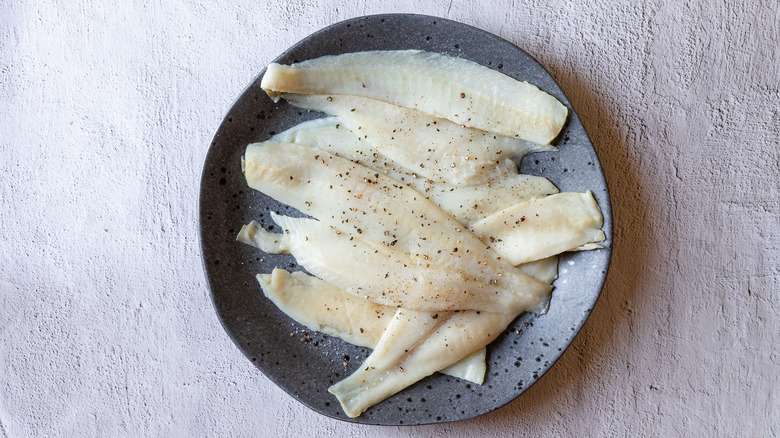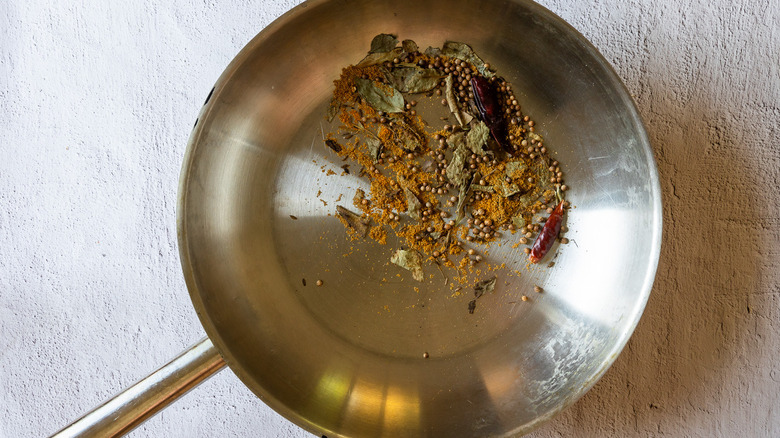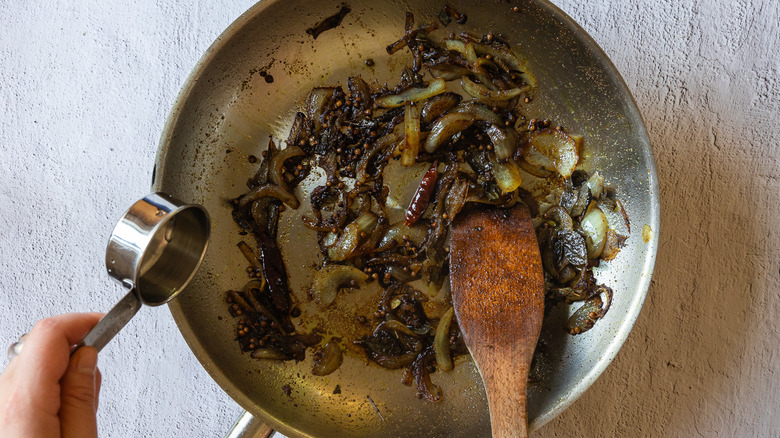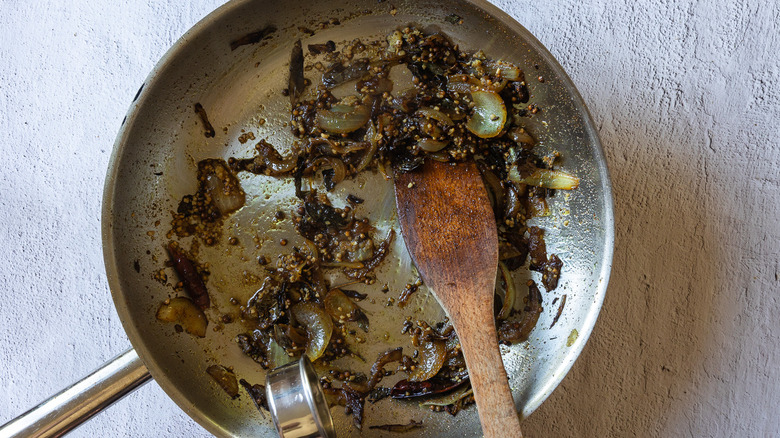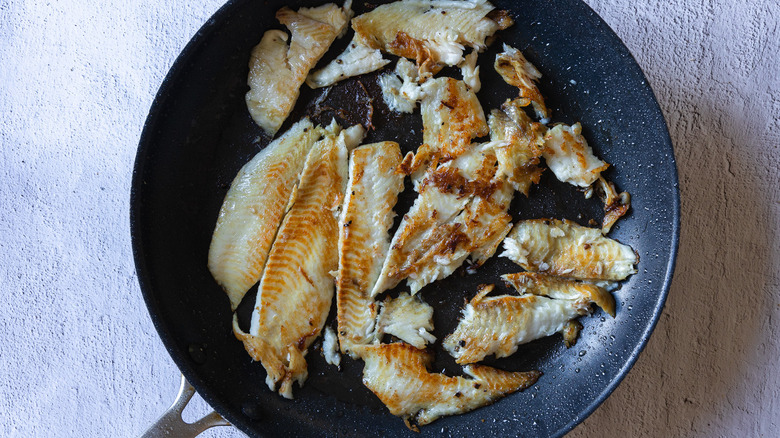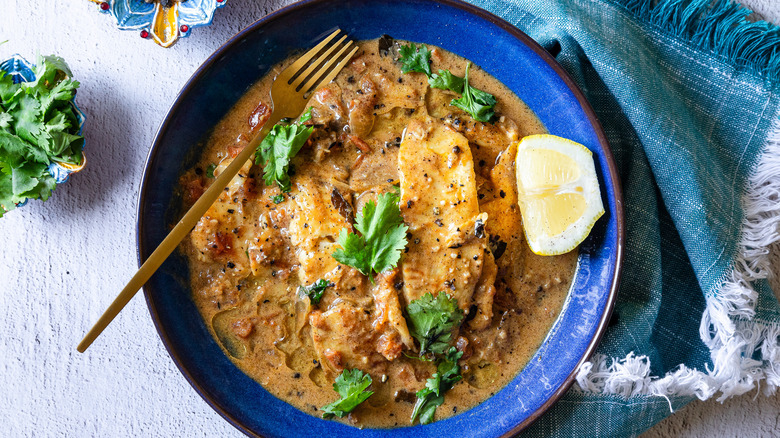South Indian Tilapia Masala Recipe
With a creamy sauce of tomatoes and coconut milk, this South Indian–inspired tilapia masala bursts with sweet flavors and warm, earthy aromas. Perfect for weeknight dinners or special feasts, it combines the delicate taste of tilapia — one of those fish you really should be cooking from frozen — with a bold, spice-infused South Indian curry sauce.
According to Ksenia Prints of At the Immigrant's Table, the key to this dish starts, as most South Asian dishes do, with toasting whole spices and curry leaves. This helps extract the maximum flavor and aroma that is hidden in the spices before we add more ingredients — namely, onions, garlic, and ginger — to develop layers of flavor.
A short cooking of the tomatoes helps concentrate their flavors, making them jammy and saucy rather than watery. Add to this a hefty dose of coconut milk, and you've got yourself a creamy, layered, and aromatic sauce that does the pan-fried fish justice.
Gather the ingredients for tilapia masala
To make this South Indian masala recipe, we start with tilapia filets as the main protein. To build the spice base, gather dried curry leaves, coriander seeds, cumin seeds, and dried red chiles, along with an optional pinch of ground cumin to bring the flavor up even more. You'll also need turmeric powder, vegetable oil, yellow onion, garlic cloves, and grated ginger. The sauce ingredients are ripe tomatoes, salt, full-fat coconut milk, and black pepper (you can also use one 16-ounce can of tomatoes if fresh tomatoes are out of season). For garnish, don't forget fresh cilantro and lemon juice.
Step 1: Season the tilapia
Season the tilapia filets with salt and black pepper, to taste.
Step 2: Toast the whole spices
In a dry skillet, toast the curry leaves, coriander seeds, cumin seeds, and dried chiles over medium heat for 1 minute, until fragrant.
Step 3: Add turmeric and cumin
Add the turmeric and ground cumin (if using), and stir to combine.
Step 4: Add the oil and onions
Add 2 tablespoons vegetable oil and the chopped onions. Saute until the onions are golden, about 10 minutes.
Step 5: Deglaze
Deglaze with ¼ cup water.
Step 6: Add the garlic and ginger
Add the garlic and ginger and saute for 2 minutes, until fragrant.
Step 7: Deglaze again
Deglaze again with 2 tablespoons water.
Step 8: Add the tomatoes
Stir in the chopped tomatoes and 1 teaspoon salt. Cook until the oil separates, about 5 minutes.
Step 9: Add the coconut milk
Pour in the coconut milk and 1 cup water. Bring to a simmer. Reduce the heat to medium, cover, and simmer while you prepare the fish.
Step 10: Heat another skillet
In a separate nonstick skillet, heat the remaining vegetable oil over medium-high heat.
Step 11: Fry the tilapia
Pan-fry the tilapia filets for 4 minutes per side, until opaque and golden.
Step 12: Add tilapia to the curry
Uncover the curry and add the pan-fried tilapia. Reduce the heat to low and allow the flavors to meld for 2–3 minutes.
Step 13: Season and serve
Top with the black pepper, cilantro, and lemon juice. Serve immediately.
South Indian Tilapia Masala Recipe
To instill serious flavor in tilapia, we pan-sear the fish and add it to a spicy coconut milk masala that's inspired by South Indian flavors.

Ingredients
- 4 tilapia filets
- 5 dried curry leaves
- 1 tablespoon coriander seeds
- 1 teaspoon cumin seeds
- 2 dried red chiles
- ½ teaspoon turmeric powder
- 3 tablespoons vegetable oil, divided
- 1 yellow onion, sliced into slivers
- 4 garlic cloves, minced
- 1 tablespoon grated ginger
- 3 ripe tomatoes, finely chopped
- 1 teaspoon salt, plus more for seasoning the fish
- 1 (13 ½-ounce) can full-fat coconut milk
- ¼ teaspoon freshly ground black pepper, plus more for seasoning the fish
- 2 tablespoons chopped cilantro
- 1 teaspoon lemon juice, or more, to taste
Optional Ingredients
- ½ teaspoon ground cumin
Directions
- Season the tilapia filets with salt and black pepper, to taste.
- In a dry skillet, toast the curry leaves, coriander seeds, cumin seeds, and dried chiles over medium heat for 1 minute, until fragrant.
- Add the turmeric and ground cumin (if using), and stir to combine.
- Add 2 tablespoons vegetable oil and the chopped onions. Saute until the onions are golden, about 10 minutes.
- Deglaze with ¼ cup water.
- Add the garlic and ginger and saute for 2 minutes, until fragrant.
- Deglaze again with 2 tablespoons water.
- Stir in the chopped tomatoes and 1 teaspoon salt. Cook until the oil separates, about 5 minutes.
- Pour in the coconut milk and 1 cup water. Bring to a simmer. Reduce the heat to medium, cover, and simmer while you prepare the fish.
- In a separate nonstick skillet, heat the remaining vegetable oil over medium-high heat.
- Pan-fry the tilapia filets for 4 minutes per side, until opaque and golden.
- Uncover the curry and add the pan-fried tilapia. Reduce the heat to low and allow the flavors to meld for 2–3 minutes.
- Top with the black pepper, cilantro, and lemon juice. Serve immediately.
Nutrition
| Calories per Serving | 437 |
| Total Fat | 33.5 g |
| Saturated Fat | 19.5 g |
| Trans Fat | 0.1 g |
| Cholesterol | 58.0 mg |
| Total Carbohydrates | 12.1 g |
| Dietary Fiber | 2.6 g |
| Total Sugars | 4.0 g |
| Sodium | 663.2 mg |
| Protein | 27.0 g |
What can I use as a substitute for curry leaves?
Curry leaves have a unique flavor that's difficult to replicate exactly, but there are still some things you can do if you can't find them. Bay leaves are a common replacement, though they lack the citrusy notes of curry leaves. For a closer match in flavor, you can combine bay leaves with a small amount of lime zest.
Some cooks recommend using basil leaves as a substitute, particularly Thai basil, which has a slightly spicier flavor than sweet basil. If you're using Thai basil, make sure to add it in the end and not during the toasting stage, as it'll burn.
Our favorite alternatives for curry leaves are makrut lime leaves, which can work well in Southeast Asian dishes. They offer a strong citrus profile and smell that works well with spicier, creamy dishes like this tilapia masala curry recipe.
What other types of fish can I use in a south Indian curry?
Tilapia is a popular choice for South Indian fish curries, but there are other fish varieties that work well in these saucy dishes. Firm, white-fleshed fish that will hold their shape when cooked are generally the best options, as they can easily absorb the rich flavors of the curry.
Pomfret, a type of butterfish, is a common choice in South Indian coastal regions. Its delicate flavor and firm texture make it ideal for curries, but it can be hard to find in North America. Kingfish is another excellent option that's prized for its meaty texture and ability to stand up to strong spices. Mackerel, though oilier, is easier to find and is also frequently used in South Indian cuisines. For those seeking a more widely available option, cod or haddock are substitutes. These fish have a mild flavor that allows the curry spices to shine, and they maintain their texture during cooking.
You can use salmon for a richer taste, though it's not traditional in South Indian cuisine and is used more in British curries. Its fatty nature and distinctive flavor can add a unique twist to the dish. For a more authentic touch, you can use fresh sardines or anchovies, which are common in some South Indian fish curries, particularly in Kerala.


